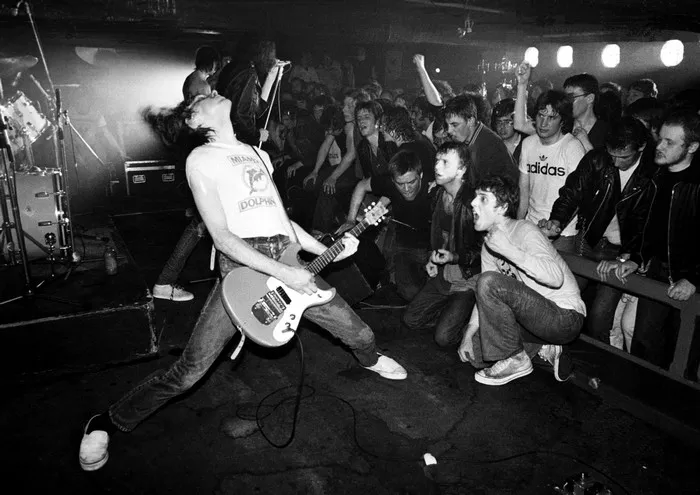Defining an Era: Rock ‘n’ Roll’s Impact on 1950s Fashion
The fusion of rock ‘n’ roll and fashion has been a defining feature of the music genre since its inception. In the 1950s, rock ‘n’ roll emerged as a cultural force, bringing with it a rebellious spirit that transcended the airwaves and influenced fashion. The charismatic Elvis Presley, with his slicked-back hair, high collared shirts, and tight-fitting pants, epitomized the rock ‘n’ roll style. His look, characterized by its fusion of edginess and elegance, inspired a generation of fans and set the stage for the enduring connection between rock music and fashion.
The Swinging Sixties: The British Invasion and Mod Style
The 1960s marked a seismic shift in both music and fashion. The British Invasion, led by bands like The Beatles, The Rolling Stones, and The Who, brought a wave of fresh sound and style to the world. Mod fashion, characterized by sharp tailoring, mini-skirts, and bold prints, became the signature look of this era. The Beatles’ collarless suits and shaggy haircuts, in particular, became iconic symbols of the mod movement, influencing fashion trends far beyond the United Kingdom.
Psychedelic Vibes and Bohemian Chic: The Late 1960s and Early 1970s
The late 1960s and early 1970s saw rock music venture into psychedelic territory, and fashion followed suit. Bands like The Doors, Jimi Hendrix, and Janis Joplin embraced a bohemian style characterized by flowing garments, fringe, and vibrant, hallucinogenic patterns. The counterculture movement, epitomized by the Summer of Love in 1967, promoted free expression and nonconformity, encouraging fans to dress in a way that reflected their personal beliefs and experiences.
Glam Rock and Gender-Bending: Bowie and T. Rex
Glam rock, led by iconic figures like David Bowie and Marc Bolan of T. Rex, revolutionized both rock music and fashion in the early 1970s. Bowie’s alter ego, Ziggy Stardust, blurred gender lines with his flamboyant outfits, androgynous makeup, and avant-garde hairstyles. This era celebrated theatricality and self-expression, pushing the boundaries of traditional masculinity and femininity. Bowie’s influence can still be seen in the androgynous styles of artists like Prince and Lady Gaga.
Punk’s DIY Revolution: Safety Pins, Leather, and Anarchy
The late 1970s gave rise to punk rock, a genre known for its raw, aggressive sound and DIY ethos. Punk fashion was a direct reflection of this rebellious spirit. Leather jackets, torn jeans, band t-shirts, and safety pins became the uniform of punk rockers. Bands like the Sex Pistols and The Ramones embodied this subculture, and their fashion choices served as a form of social commentary, challenging the establishment and consumer-driven society.
Rock’s Fashion Icons: Michael Jackson and Madonna
The 1980s brought a new wave of rock and pop stars who left an indelible mark on fashion. Michael Jackson’s military-inspired jackets, sequined gloves, and high-water pants set the stage for an era of fashion-forward pop icons. Madonna, the “Queen of Pop,” reinvented herself with each album, influencing trends such as lace gloves, layered jewelry, and corset tops. Both artists embraced theatricality and visual storytelling, using their fashion choices to enhance their stage personas.
Grunge and the 1990s: Flannel, Doc Martens, and Cobain
The grunge movement of the 1990s, led by bands like Nirvana and Pearl Jam, rejected the excesses of the 1980s and embraced a more understated, anti-fashion aesthetic. Kurt Cobain’s disheveled cardigans, ripped jeans, and Converse sneakers became synonymous with the grunge look. This subversion of traditional fashion norms resonated with a generation disillusioned by consumerism and celebrity culture.
Nu-Metal and Hip-Hop Fusion: Baggy Jeans, Bandanas, and Bling
The late 1990s and early 2000s witnessed a fusion of rock and hip-hop, giving rise to nu-metal bands like Limp Bizkit and Linkin Park. This genre brought with it a unique fashion sense characterized by baggy jeans, oversized t-shirts, bandanas, and bling. Artists like Fred Durst and Chester Bennington embraced this blend of styles, creating a distinct aesthetic that appealed to a diverse audience.
The Present and Beyond: Diversity and Individuality
In the 21st century, rock music and fashion have continued to evolve, embracing diversity and individuality. Artists like Billie Eilish challenge conventional beauty standards with their unique style, while bands like Twenty One Pilots blend genres and aesthetics to create a fresh, eclectic look. The digital age has also democratized fashion, allowing musicians and fans to connect and experiment with styles like never before, breaking down traditional boundaries and opening the door to endless possibilities.
Conclusion: A Timeless Partnership
The relationship between rock music, fashion, and subcultures has proven to be enduring and dynamic. From the rebelliousness of rock ‘n’ roll’s beginnings to the diversity and individuality of today’s scene, fashion and music continue to feed into each other, shaping and reflecting the cultural landscape. As new generations of artists and fans emerge, this symbiotic connection ensures that rock music will forever remain a driving force in the ever-evolving world of fashion and subcultures, leaving its mark on the runway and in the hearts of those who dare to rock their style.

